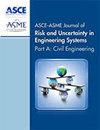基于故障树构建的高后果区长输站安全运行风险评估方法——以中缅天然气管道分站为例
IF 2.7
3区 工程技术
Q2 ENGINEERING, CIVIL
Asce-Asme Journal of Risk and Uncertainty in Engineering Systems Part A-Civil Engineering
Pub Date : 2023-03-01
DOI:10.1061/ajrua6.rueng-960
引用次数: 0
摘要
天然气长输站的安全运行是天然气可持续输送的关键环节。因此,高后果区车站运行风险评估与时空表达已成为亟待解决的关键问题。传统的天然气管道故障概率评估方法已不能满足天然气运营公司对天然气站安全评估的要求。以中缅天然气管道分站为例,介绍了基于模糊故障树模型(FFT)的管道安全综合评价方法(CPSE-FFT),对站区管道运行的风险因素及其带来的社会安全风险进行了评价。以中缅长输管道某分支站为例进行了实例分析。结果表明,该站区域管道事故发生概率为5.79×10−4次/年,风险分布图上还暴露了37座建筑物中风险等级较高的6座建筑物。总体的社会风险水平也被表达出来。CPSE-FFT是一种实用、合理、准确的评价方法,能够定量反映天然气站安全运行风险。该方法适用于大多数天然气站的风险评估。风险评估结果为管理者和决策者降低天然气站风险提供了参考。本文章由计算机程序翻译,如有差异,请以英文原文为准。
Risk Assessment Method for the Safe Operation of Long-Distance Pipeline Stations in High-Consequence Areas Based on Fault Tree Construction: Case Study of China–Myanmar Natural Gas Pipeline Branch Station
The safe operation of natural gas long-distance pipeline stations is the critical link for its sustainable transmission. Therefore, station operation risk assessment and space-time expression in high consequence areas have become a critical problem that must be urgently addressed. The conventional way to assess the probability of gas pipeline failure cannot meet the requirements of the natural gas operating companies for the safety assessment of natural gas stations. Taking the example of the China–Myanmar natural gas pipeline branch station, based on the fuzzy fault tree model (FFT), a comprehensive pipeline safety evaluation method (CPSE-FFT) has been introduced, which evaluates the risk factor of pipeline operation in the station area and the social security risk brought by it. In this case study, the method is applied to a branch station of the China–Myanmar long-distance pipeline. In the results, the probability of pipeline accidents in the area of the station is 5.79×10−4 times/year, and six buildings with higher risk levels among the 37 buildings are also exposed on the risk distribution map. The overall social risk level is also expressed. CPSE-FFT is a practical, reasonable, and accurate assessment method that can quantitatively reflect the risks posed by the safe operation of natural gas stations. This method is suitable for most natural gas station risk assessments. The results of the risk assessment provide a reference for managers and decision-makers to reduce the risk of natural gas stations.
求助全文
通过发布文献求助,成功后即可免费获取论文全文。
去求助
来源期刊

Asce-Asme Journal of Risk and Uncertainty in Engineering Systems Part A-Civil Engineering
Engineering-Building and Construction
CiteScore
5.30
自引率
8.00%
发文量
86
期刊介绍:
The journal will meet the needs of the researchers and engineers to address risk, disaster and failure-related challenges due to many sources and types of uncertainty in planning, design, analysis, construction, manufacturing, operation, utilization, and life-cycle management of existing and new engineering systems. Challenges abound due to increasing complexity of engineering systems, new materials and concepts, and emerging hazards (both natural and human caused). The journal will serve as a medium for dissemination of research findings, best practices and concerns, and for the discussion and debate on risk and uncertainty related issues. The journal will report on the full range of risk and uncertainty analysis state-of-the-art and state-of-the-practice relating to civil and mechanical engineering including but not limited to:
• Risk quantification based on hazard identification,
• Scenario development and rate quantification,
• Consequence assessment,
• Valuations, perception, and communication,
• Risk-informed decision making,
• Uncertainty analysis and modeling,
• Other related areas.
Part A of the journal, published by the American Society of Civil Engineers, will focus on the civil engineering aspects of these topics. Part B will be published by the American Society of Mechanical Engineers focusing on mechanical engineering.
 求助内容:
求助内容: 应助结果提醒方式:
应助结果提醒方式:


